8.12
My Enemy, Myself
Karim Ben Khelifa
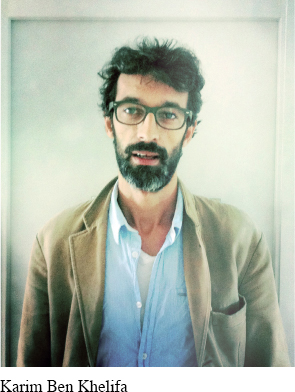
Karim Ben Khelifa (b. 1972), a freelance photojournalist who has covered conflicts around the world, is also a fellow at the Nieman Foundation for Journalism at Harvard University. His award-
KEY CONTEXT To help you understand the context of the photos and the subjects’ comments, you may want to familiarize yourself with the following brief summaries of the three conflicts that Ben Khelifa documents in his photo essay:
The Gaza Strip: The site of one of the world’s most intractable conflicts, the Gaza Strip is a twenty-
Kashmir: Kashmir is a disputed territory with a long history of occupation. India, Pakistan, and China all lay claim to portions of the area in the northwest portion of the Indian subcontinent; Pakistan and India have fought several wars over the territory. Some of the most violent conflicts occur in the Kashmir Valley, which is administered by India, a majority Hindu nation. Residents of the area, the majority of whom are Muslim, say that they would prefer to be independent or to be a part of Pakistan, a majority Muslim nation. India has long accused Pakistan of training and arming the residents of Kashmir as terrorists.
South Sudan: The most recent aspects of the conflict in South Sudan can be traced to the ongoing clashes in 2011 between two of the largest clans in the area, the Murle and the Lou Nuer. Each side accuses the other of stealing cattle and burning villages. Hundreds of people on both sides of the conflict have been killed and thousands have had to flee their homes. The conflict has been made worse by recent drought conditions and the weakness of the central government in the newly independent South Sudan.
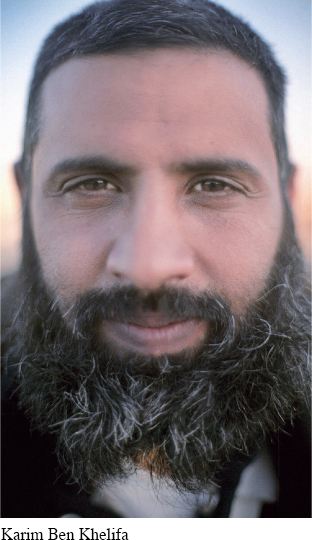
Gaza
 “My name is Abu Yasser; I’m 32 years old and I’m a commander in the Al Aqsa Brigade, Jihad al-
“My name is Abu Yasser; I’m 32 years old and I’m a commander in the Al Aqsa Brigade, Jihad al-
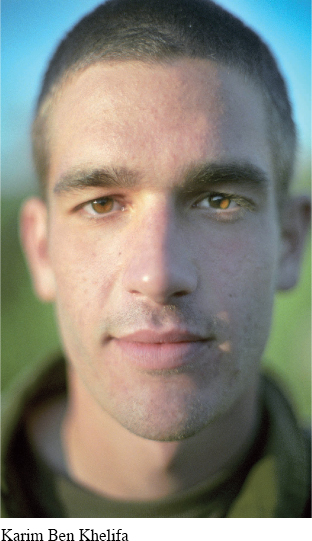
Gaza
 “My name is Tomer Brok; I’m 19 years old. I’m a sergeant in the Israeli army. My enemy is anybody that threatens the country, the safety of its civilians, and the free life we lead. I never encountered my enemy face to face, and therefore I never killed one of them. My biggest fear is that people here will stop thinking it’s important to get to the army and that will slowly lead to our destruction and the disappearance of our freedom. Freedom to me is each individual being able to live his life with dignity as he wishes and without fear. Terrorism for me is wanting to take away the freedom of others. At the end it’s taking away the right to choose and the liberty that everyone should have just for being a person. My goal in life is first of all to do in the army all I can to protect my country and in the future to go ahead and build a family and to stay in Israel and never leave it; this is where my roots are. And to continue to give to the country as a civilian.”
“My name is Tomer Brok; I’m 19 years old. I’m a sergeant in the Israeli army. My enemy is anybody that threatens the country, the safety of its civilians, and the free life we lead. I never encountered my enemy face to face, and therefore I never killed one of them. My biggest fear is that people here will stop thinking it’s important to get to the army and that will slowly lead to our destruction and the disappearance of our freedom. Freedom to me is each individual being able to live his life with dignity as he wishes and without fear. Terrorism for me is wanting to take away the freedom of others. At the end it’s taking away the right to choose and the liberty that everyone should have just for being a person. My goal in life is first of all to do in the army all I can to protect my country and in the future to go ahead and build a family and to stay in Israel and never leave it; this is where my roots are. And to continue to give to the country as a civilian.”

Kashmir
 “My name is Kashmir Singh; I’m 40 years old. I am a policeman, I have joined the police forces 23 years ago to serve my country. My enemy is the one who breaks the law of my country. I have met my enemies face to face, and they do not scare me. We have been attacked by our enemies several times, and I killed many of them. If someone endangers us and the laws, we might have to kill him in order to protect us. Terrorism is harmful for everyone, and we will fight it until the end. In the next 20 years, India will grow to become the first country in the world. I wish peace and harmony for my life.”
“My name is Kashmir Singh; I’m 40 years old. I am a policeman, I have joined the police forces 23 years ago to serve my country. My enemy is the one who breaks the law of my country. I have met my enemies face to face, and they do not scare me. We have been attacked by our enemies several times, and I killed many of them. If someone endangers us and the laws, we might have to kill him in order to protect us. Terrorism is harmful for everyone, and we will fight it until the end. In the next 20 years, India will grow to become the first country in the world. I wish peace and harmony for my life.”

Kashmir
 “My name is Bilal Ahmed. I am 32 years old. I have been throwing stones since 1993 because India is constantly harassing us. My enemy is India. I am not afraid of anything except God. I haven’t killed anyone because I am a Muslim and Islam forbids us to harm innocent people. God has created every human being, and I have no right to go against God’s will. I fear only one thing—
“My name is Bilal Ahmed. I am 32 years old. I have been throwing stones since 1993 because India is constantly harassing us. My enemy is India. I am not afraid of anything except God. I haven’t killed anyone because I am a Muslim and Islam forbids us to harm innocent people. God has created every human being, and I have no right to go against God’s will. I fear only one thing—
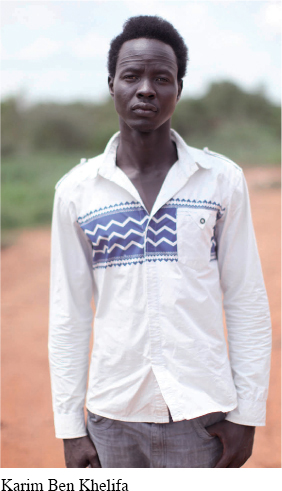
South Sudan
 “My name is Paulino Kueth; I’m 28 years old. I’m a member of the Lou Nuer. My enemies are the Murle. They designated themselves as our enemies. The problem is the cattle; the Murle come to steal it. The fighting is historical: They kill and we kill them in return. We can’t deny that we have also killed; people fought for so long now. People have suffered: Your cattle has been taken; your children are abducted; you are not allowed to work your land; you feel hunger and you go without food for a long period of time. All those things are the result of the conflict. Nobody has been solving the problem and addressing it until recently. People were not blaming the government, maybe because of the scarcity of the resources. Freedom is a situation that allows you to interact with people. If we can interact, you and I, it is because of freedom. Freedom is something that can help to find a solution to solve a lot of problems like addressing hunger, the problem of fighting. Previously people were under the rule of north Sudan. We had no freedom because people were not interacting. We had no future plan, or to think of what might happen, but this time around we feel we have freedom. We are under our own rules. You can even think peace as a result of freedom. Violence is a situation where there is a lot of poverty, a lack of knowledge, no valuing of the importance of other human beings. That is why you have killings, but if you know that there is another human in front of you, you can’t simply kill another person. Therefore if people get together, sharing knowledge, they will value other human beings.”
“My name is Paulino Kueth; I’m 28 years old. I’m a member of the Lou Nuer. My enemies are the Murle. They designated themselves as our enemies. The problem is the cattle; the Murle come to steal it. The fighting is historical: They kill and we kill them in return. We can’t deny that we have also killed; people fought for so long now. People have suffered: Your cattle has been taken; your children are abducted; you are not allowed to work your land; you feel hunger and you go without food for a long period of time. All those things are the result of the conflict. Nobody has been solving the problem and addressing it until recently. People were not blaming the government, maybe because of the scarcity of the resources. Freedom is a situation that allows you to interact with people. If we can interact, you and I, it is because of freedom. Freedom is something that can help to find a solution to solve a lot of problems like addressing hunger, the problem of fighting. Previously people were under the rule of north Sudan. We had no freedom because people were not interacting. We had no future plan, or to think of what might happen, but this time around we feel we have freedom. We are under our own rules. You can even think peace as a result of freedom. Violence is a situation where there is a lot of poverty, a lack of knowledge, no valuing of the importance of other human beings. That is why you have killings, but if you know that there is another human in front of you, you can’t simply kill another person. Therefore if people get together, sharing knowledge, they will value other human beings.”
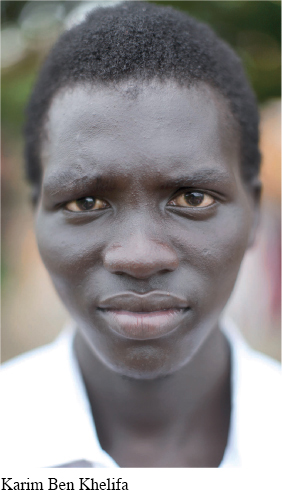
South Sudan
 “My name is John Akuer Aborcup; I’m 18 years old. My enemy is the one who comes to attack me. Members of the Lou Nuer tribe have attacked us, but we also had to fight with members of the Dinka Bor tribe. Those tribes are our enemies because sometimes we go and take their cattle and they come back to attack us; they have killed our people. The Lou Nuer recently came to Pibor and killed my three uncles. They looted all our cattle; they burned all our houses. They cannot be my friends anymore; they have destroyed us. Those are my enemies, and I will have to take revenge. My first reaction has to take revenge and to go to the Lou Nuer land to fight the people who have attacked us. But that means that I could die and I would not be able to help my people. Freedom for me is to be able to mobilize my community, to defend my people. And violence is for me to go and attack my enemies, to get stuck in a tribal war. I think 20 years from now, all tribes will live in peace because towns are growing and reaching smaller villages, bringing development, schools, roads, and business, so the next generation can be educated. We started the tribal wars a thousand years ago. Now we use Kalashnikovs. Tomorrow I hope we will use pencils.”
“My name is John Akuer Aborcup; I’m 18 years old. My enemy is the one who comes to attack me. Members of the Lou Nuer tribe have attacked us, but we also had to fight with members of the Dinka Bor tribe. Those tribes are our enemies because sometimes we go and take their cattle and they come back to attack us; they have killed our people. The Lou Nuer recently came to Pibor and killed my three uncles. They looted all our cattle; they burned all our houses. They cannot be my friends anymore; they have destroyed us. Those are my enemies, and I will have to take revenge. My first reaction has to take revenge and to go to the Lou Nuer land to fight the people who have attacked us. But that means that I could die and I would not be able to help my people. Freedom for me is to be able to mobilize my community, to defend my people. And violence is for me to go and attack my enemies, to get stuck in a tribal war. I think 20 years from now, all tribes will live in peace because towns are growing and reaching smaller villages, bringing development, schools, roads, and business, so the next generation can be educated. We started the tribal wars a thousand years ago. Now we use Kalashnikovs. Tomorrow I hope we will use pencils.”
Understanding and Interpreting
In the texts accompanying the pair of photos about Gaza, both men discuss the concept of “freedom.” How are their views on this topic similar and different?
How do the two men on opposing sides of the conflict in Kashmir define a “terrorist”?
Both Sudanese men use the word “enemy.” According to each man’s point of view, how is he similar to his enemy?
While each of the three conflicts is clearly unique, what similarities do they share? Base your answer only on what you have read or seen in these texts.
There is an expectation that journalists attempt to be unbiased. Use visual and textual evidence to demonstrate whether Ben Khelifa is, or is not, unbiased.
While Ben Khelifa never explicitly states it, what is the overall point he is making about the causes and effects of war? What visual and textual evidence supports your conclusion?
Analyzing Language, Style, and Structure
The pictures in this essay are not “action” photographs like most of Ben Khelifa’s photojournalism. What is the effect on the reader of his choice of portraiture? What effect do you think Ben Khelifa intends to achieve by having his subjects look directly into the camera?
Most of the pictures are close-
ups or have blurred backgrounds, which makes it is difficult for viewers to tell where the photographs were taken. How does this choice support the larger point that Ben Khelifa is trying to make? It is clear that the texts accompanying the photos are the result of Ben Khelifa’s asking each man roughly the same questions. What are the questions that he likely asked? How do the implicit questions themselves reflect Ben Khelifa’s point of view?
In the photos, what are the similarities and differences between how the men in opposing conflicts are represented—
in clothing, weapons, facial expressions, gestures, and so on? What is the effect of these similarities and differences?
Connecting, Arguing, and Extending
What is the role of a photojournalist? How is it similar to and different from that of a print or television journalist? Locate a photo essay online and explain how it both fits and does not quite fit the traditional definition of journalism.
Research the jobs of reporters like Ben Khelifa who cover wars and conflicts around the world. Good places to start include the organization Reporters without Borders and the Society of Professional Journalists. What dangers do these journalists face and what are the results of their work?
Create your own photo essay about people in your school or the city or town in which you live. Try to focus on people who might be different from each other in some kind of way. Your photo essay could focus on different cliques at school, or people from different ethnic, religious, socioeconomic, or cultural groups. Ask the same two or three questions of each of your subjects and include the answers in captions for your photographs, as Ben Khelifa did in this photo essay.